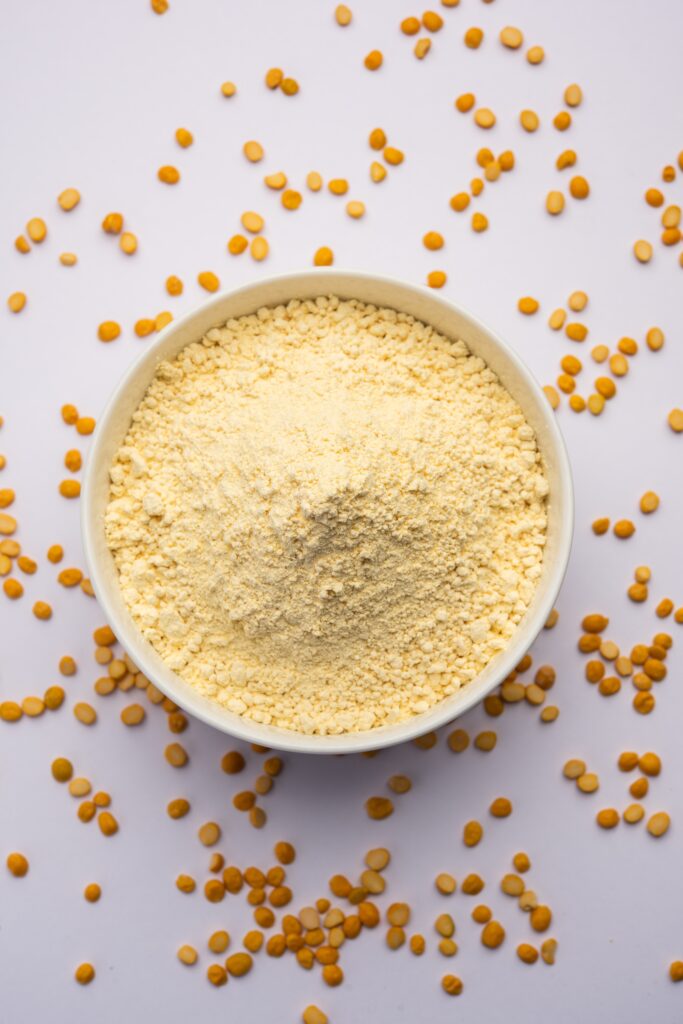
If you’ve ever dipped a crispy pakora into mint chutney or made a quick face mask in your kitchen, chances are you’ve already used besan. Also known as gram flour, this humble yellow powder has been at home in both cooking and skincare for generations.
From rainy-day fritters to pre-wedding beauty rituals, besan does a bit of everything. It’s packed with nutrients, easy to work with, and endlessly useful.
So what makes it stand out from other flours? Let’s look at how this simple ingredient finds its way into so many dishes — and even onto your skincare shelf — without missing a beat.
What Exactly Is Besan (Gram Flour)?
Besan is a fine flour made by grinding split chickpeas — specifically chana dal, a type of yellow lentil. Despite the common confusion, it’s not the same as chickpea flour made from whole garbanzo beans. Besan has a slightly denser texture and a richer, earthier feel, making it especially popular in South Asian and Middle Eastern kitchens.
Naturally gluten-free, protein-packed, and light golden in color, besan plays a key role in savory dishes, batter-based recipes, and even home remedies. Whether you’re frying snacks, thickening curries, or whipping up a DIY face mask, this flour has a way of fitting in without fuss.
- What it is: Fine flour made from split brown chickpeas (chana dal); not the same as chickpea flour from whole kabuli chickpeas.
- Flavor & texture: Nutty and earthy; slightly bitter when raw, mellow and savory once cooked.
- Best in: Pakoras, chilla pancakes, kadhi, dhokla, Burmese tofu, and Mediterranean socca or farinata.
- Other uses: Traditional face masks (ubtan), natural cleanser, and gentle body scrub in skincare rituals.
- Prep basics: Roast lightly for a deeper flavor; whisk with water for smooth batters; as an egg replacer use 1 tablespoon besan + 3 tablespoon water.
- Flavor pairings: Turmeric, cumin, ajwain, chili, hing, ginger, garlic, onions, green chilies, yogurt, lemon, and mint.
- Nutrition: Naturally gluten-free; about 36 kcal per tbsp; 2 g protein, 6 g carbs, 1 g fiber, 1 g fat, plus iron and folate.
- Storage: Keep in an airtight container in a cool, dry place; refrigerate in humid climates; lasts up to 6 months.
What It Tastes Like
Besan has a nutty, earthy flavor with a slightly bitter edge when raw. Once cooked, that bitterness softens and gives way to a warm, savory taste — perfect for dishes that need depth without heaviness.
Its flavor is bold enough to stand on its own in snacks like pakoras but mild enough to blend into breads, batters, and sweets. If you’ve ever tasted a crispy onion bhaji or a soft Gujarati dhokla, you’ve already experienced its unique charm.
Culinary Uses Around the World
While besan has deep roots in South Asian cooking, its versatility has earned it a place in kitchens across the globe.
- India & Pakistan: Used in everything from crispy pakoras and fluffy dhoklas to kadhi pakora and creating savory pancakes like chilla.
- Myanmar (Burma): Forms the base for Burmese tofu, a vegan-friendly, soy-free version made entirely from chickpea flour.
- France & Italy: In the Mediterranean, it becomes socca (Nice) or farinata (Genoa) — thin, crisp-edged flatbreads baked in wood-fired ovens.
- Middle East & North Africa: Besan is often used to add body to stews or turned into fritters like falafel (sometimes mixed with other flours or legumes).
- Gluten-Free Baking Worldwide: A go-to flour in modern gluten-free kitchens for baking cookies, breads, and pancakes thanks to its binding power and nutty taste.
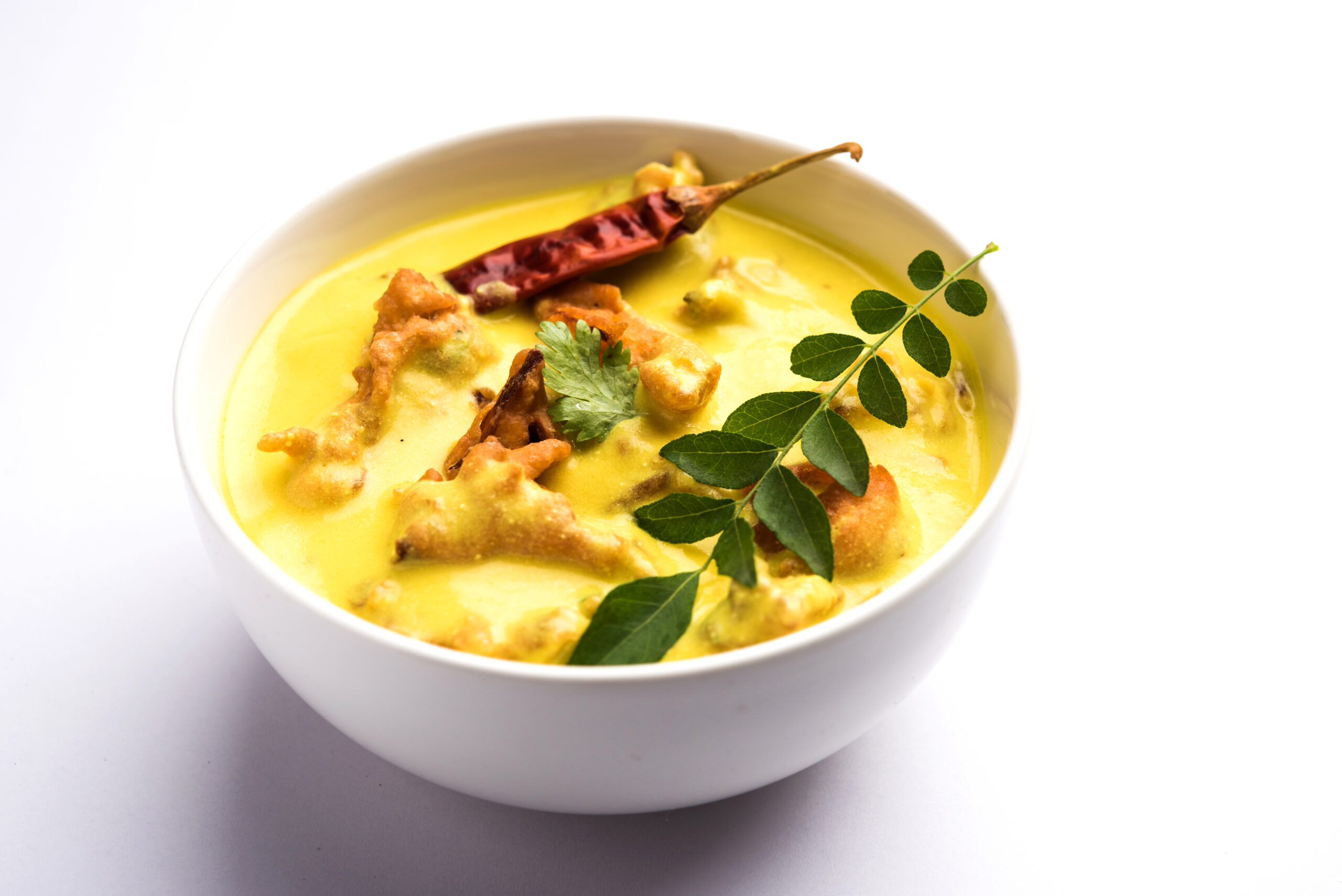
A comforting bowl of kadhi pakora, where tangy yogurt meets golden gram flour fritters in a creamy swirl.
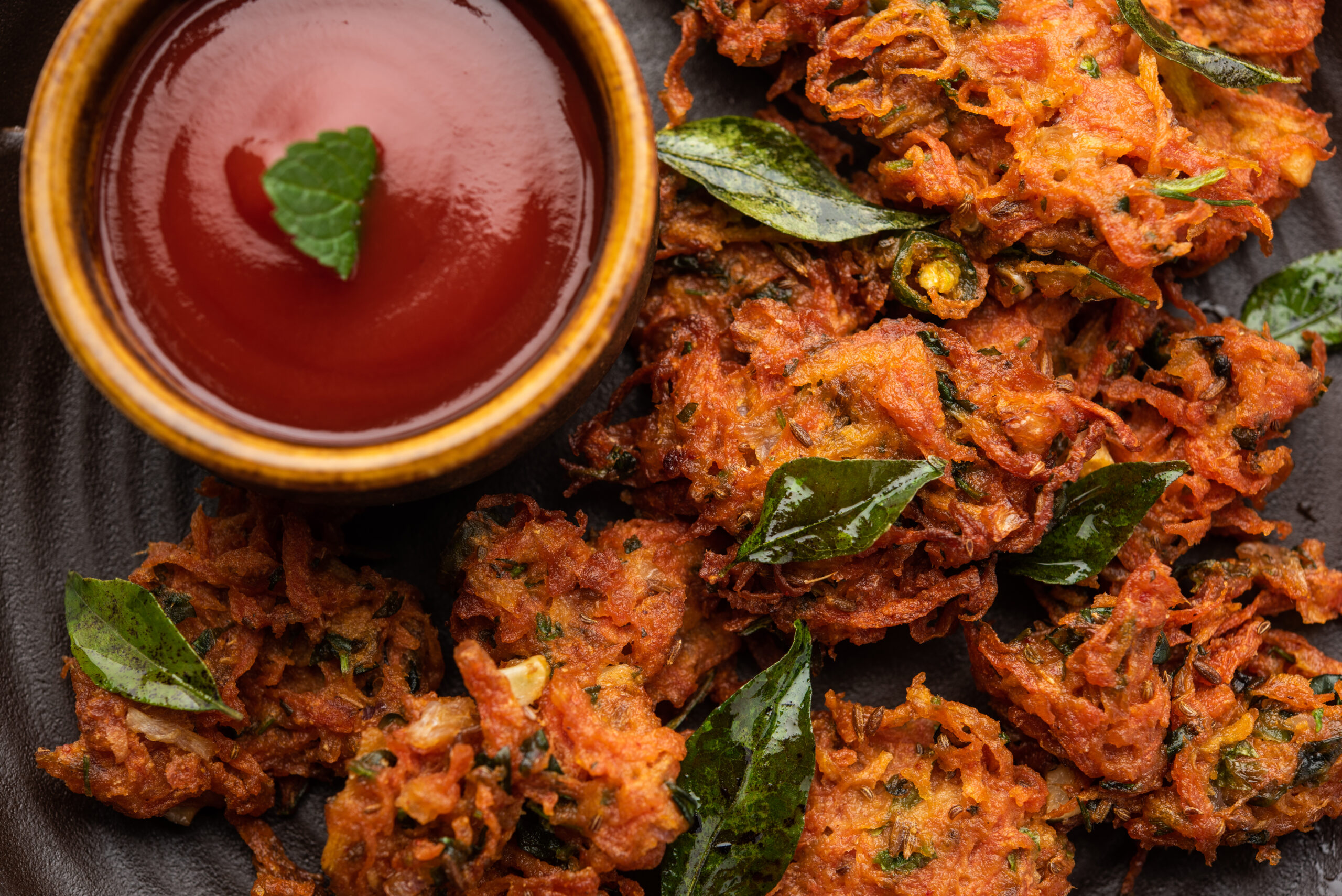
Besan-coated pakoras, crispy on the outside and soft inside.
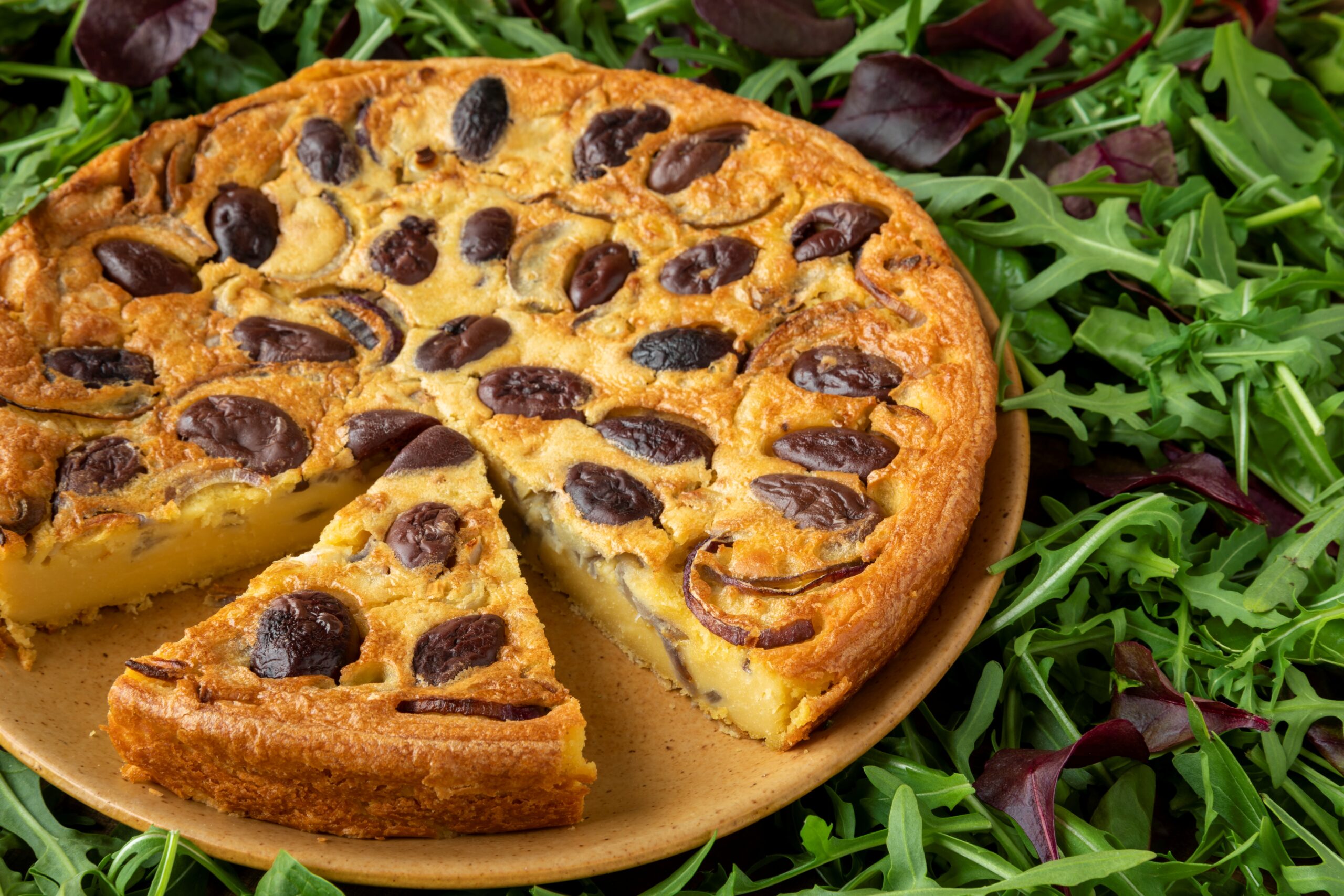
Farinata with Kalamata olives — Italy’s savory chickpea pancake made with besan and full of rustic charm.
Cooking With Besan
Besan isn’t your average flour — it behaves a little differently, and that’s exactly what makes it so useful.
It toasts beautifully, develops a deeper flavor when roasted, and thickens sauces without clumping. When mixed with water, it forms a smooth, sticky batter that can be fried into crispy fritters or steamed into soft, spongy cakes. It also works as a binder in veggie patties and as a gluten-free coating for frying anything from fish to eggplant.
Here are a few handy ways to use it in the kitchen:
- Roast it first for a nutty depth in laddoos, curries, or savory gravies.
- Mix into batters for frying, coating, or creating pancakes (chilla).
- Use it as an egg replacer — just mix 1 tablespoon of besan with 3 tablespoons of water for a quick vegan alternative.
Besan in Traditional Remedies and Skincare
Besan has long been a trusted beauty staple in South Asian homes — especially before big events or festivals.
- Wedding ubtan rituals: A paste of besan, turmeric, and milk or rose water is still used to brighten and soften the skin of brides and grooms.
- Homemade face masks: Mixed with yogurt, lemon, or honey to help cleanse, reduce oil, and improve skin tone.
- Body scrub: Used with water or oil to gently exfoliate and refresh the skin.
- Baby care: In some traditions, besan was used in place of soap for newborns due to its soft, soothing properties.
Passed down through generations, besan was (and still is) skincare straight from the kitchen.
Modern Self-Care and Beauty Trends
Besan has made a smooth comeback in today’s clean beauty movement — now found in everything from natural exfoliators to luxury face packs.
- DIY skincare routines: Skincare enthusiasts on YouTube and Instagram often blend besan with aloe vera, rose water, or green tea for targeted masks.
- Acne-prone skin care: Thanks to its oil-absorbing nature, besan is used in modern clay mask blends to help with breakouts and shine.
- Scalp masks: Mixed with yogurt or apple cider vinegar, it may help reduce oiliness and dandruff naturally.
- Beauty brands go back to basics: A few modern natural beauty brands now include besan as a key ingredient in powdered cleansers and facial polishes.
Flavor Pairings
Besan’s earthy, nutty taste plays well with bold and aromatic flavors.
- Best spice partners: Turmeric, cumin, ajwain (carom seeds), red chili, and hing (asafoetida) enhance besan’s depth — especially in batters and savory dishes.
- Fresh flavors: Ginger, garlic, onions, and green chilies bring brightness to besan-based snacks and pancakes.
- Cooling balances: Yogurt, lemon juice, or mint help mellow its richness and add tangy contrast — especially in chaats or kadhi.
Besan’s flavor is humble but flexible, making it a reliable base for both comforting and vibrant dishes.
Besan Substitutes
Out of besan? No worries — a few pantry staples can come to the rescue, depending on what you're cooking.
- Chickpea flour (garbanzo flour): The closest match. It’s made from whole chickpeas instead of split ones, so it’s slightly coarser but works in most recipes.
- All-purpose flour (maida): Good for binding in fritters or flatbreads, though it lacks the nutty flavor and nutrition of besan.
- Rice flour: Lighter and crisper, ideal in batters when you're after crunch. Best paired with a little cornstarch for texture.
- Oat flour or whole wheat flour: Decent for thickening soups or using in baked goods but will change the taste and texture noticeably.
Substitutes work in a pinch, but nothing quite replaces that signature taste and feel of true besan.
How to Store It Right
Besan is sensitive to moisture and odors, so a little care goes a long way:
- Airtight container: Store it in a sealed jar or container to keep out humidity and pantry pests.
- Cool, dark place: Keep it away from direct sunlight or heat — a kitchen cabinet works fine.
- Refrigerate for longer life: In warm or humid climates, popping it into the fridge can help it stay fresh and bug-free for up to 6 months.
- Smell check: If it starts to smell sour or musty, it’s time to toss and replace.
Nutritional Value (Per Tablespoon or Gram)
Besan is more than just tasty — it packs a decent nutritional punch in every spoonful.
Approximate values per 1 tablespoon (10g):
- Calories: 36
- Protein: 2g
- Carbohydrates: 6g
- Fiber: 1g
- Fat: 1g
- Iron: 0.6 mg (about 3% of the daily value)
- Folate: 45 mcg (roughly 10% of the daily value)
Health Benefits of Besan
Besan isn’t just a kitchen essential — it may offer some surprising health perks, too.
- May support weight management: Thanks to its high fiber and protein content, besan can help keep you full longer and curb those snack cravings (Source).
- Can help balance blood sugar: Its lower glycemic index means it may cause slower rises in blood sugar compared to refined flours (Source).
- Supports heart health: It contains healthy unsaturated fats and may help reduce bad cholesterol when used in place of white flour (Source).
- May aid digestion: Besan is naturally rich in fiber, which can help support a healthy gut and regular digestion (Source).
- Good for vegetarians and vegans: It’s a plant-based source of protein, iron, and folate — all important for energy and immunity (Source).
Potential Health Risks
Besan is generally safe for most people, but a few things are worth noting:
- Allergies: Though rare, some people may have sensitivities or allergic reactions to legumes, including chickpeas (Source).
- Flatulence or bloating: Since it’s high in fiber, sudden overconsumption may cause gas or bloating — especially if your gut isn’t used to it (Source).
- Cross-contamination: If you're buying from bulk bins or local mills, make sure it hasn’t been mixed with gluten flours if you're gluten-sensitive.
As always, moderation and proper cooking are key to getting the most from this flour without any side effects.
Final Thoughts
Besan isn’t just another flour — it’s a kitchen and skincare staple that’s been trusted for ages. Whether you’re frying up golden pakoras or mixing a quick face mask, it adds both flavor and function with a hint of tradition.
It’s simple, nutritious, and still feels surprisingly current for something so old.
FAQs
Is besan the same as chickpea flour?
Not exactly. While both come from chickpeas, besan is made from split brown (desi) chickpeas, while typical chickpea flour (especially in Western markets) is often made from whole white (kabuli) chickpeas.
Is besan gluten-free?
Yes, besan is naturally gluten-free. However, always check the label if you’re highly sensitive, as some mills may process it alongside wheat.
Can I use besan for baking?
Yes, you can! It adds a slightly nutty flavor and works well in gluten-free baking, especially in pancakes, savory muffins, or flatbreads.
How long does besan last once opened?
If stored in an airtight container in a cool, dry place, it can last up to 6 months. For longer shelf life, refrigerate it.
Can I use besan on my skin every day?
While it’s gentle, using it every day may dry out some skin types. Try 2–3 times a week and always follow with a moisturizer.
Learn More About Besan (Gram Flour)
Wikipedia – Gram Flour
This article is explaining what gram flour (besan) is, how it’s made from ground chickpeas, and its various culinary uses across South Asian, Mediterranean, and other global cuisines. It also highlights regional names, types of chickpeas used, and common dishes prepared with it.
Vegan Richa – Difference Between Besan and Chickpea Flour
This article is covering the difference between besan and chickpea flour, focusing on how besan is made from split brown (desi) chickpeas while chickpea flour is usually made from whole white (kabuli) chickpeas. It also discusses how their texture, flavor, and performance in recipes can differ.


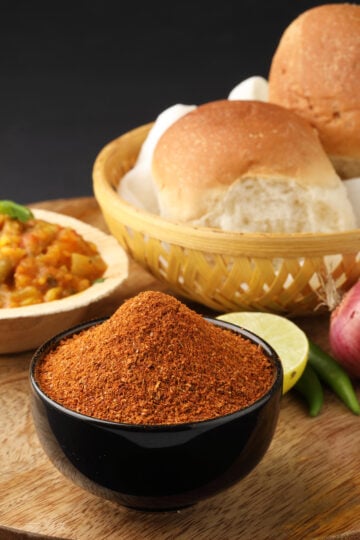
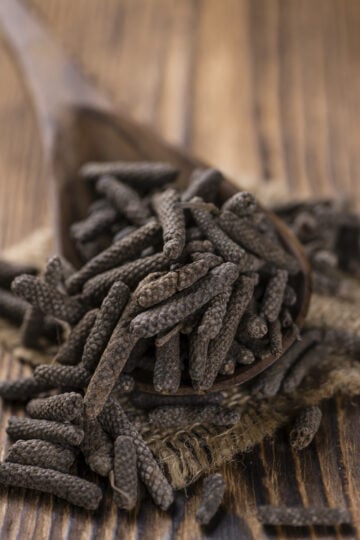
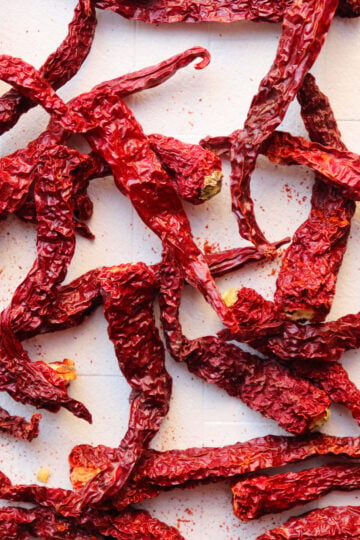
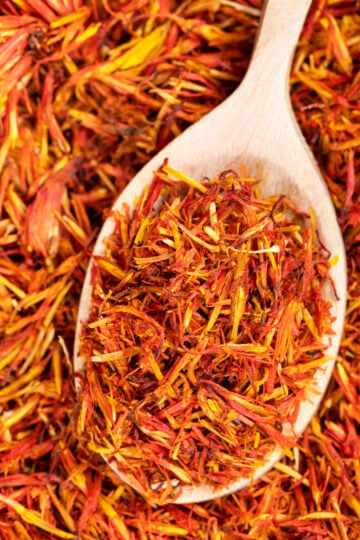
Have a question or something to share? Leave a comment below!